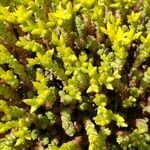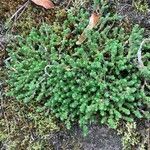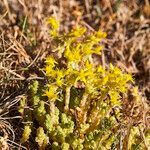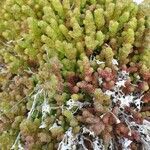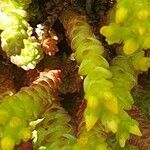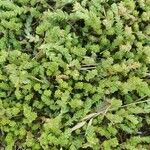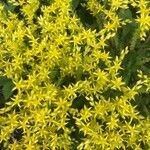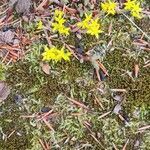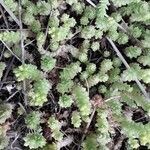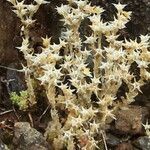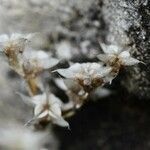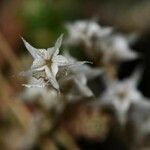Glabrous, often mat-forming, perennial herb, with creeping stems freely rooting at nodes and numerous short erect sterile and flowering stems. Lvs alternate, sessile, densely arranged up the erect stems, imbricate but not in terminal rosettes, 4-5 × 2.5-3 mm, c. 1.5 mm thick, ± broadly cordate-ovate, convex above and below, entire, green or yellowish green but old lvs persisting and white; apex obtuse. Infl. terminal, < 1.5 cm long, a short open cyme 0.5-3 cm across and with 1-3 branches, each branch with up to 4 fls and a leaflike bract. Fls sessile or subsessile, somewhat secund. Sepals unequal, 3-4 mm long, broad-ovate and very similar to lvs. Petals 5, ± patent, 6.5-7.5 × c. 3 mm, ovate-elliptic, yellow, acute. Stamens 5-6 mm long, yellow. Carpels and styles yellow. Scales semi-lunate to ± rectangular. Follicles yellow, widely divergent. Seed 0.5-0.8 mm long, ± narrowly ellipsoid or ellipsoid-obovoid, longitudinally ribbed.
Fibrous-rooted evergreen perennial from creeping stems, forming mats; flowering stems 5–10 cm, the lower part commonly clothed with persistent dead lvs; lvs crowded, imbricate, ovoid, terete, 2–5 mm, blunt; infl of 2 (–several) short, branched, sympodial cymes; fls 5-merous; pet yellow, 6–8 mm, spreading, connate for ca 0.5 mm; filaments basally adnate to the minute cor-tube; carpels erect in fl, divergent in fr; 2n=80. Native of Eurasia, cult. in many forms, and often escaped in our range, especially northward. June, July.
A small succulent plant. It grows 5-10 cm high and spreads 30-60 cm wide. It keeps growing from year to year. It forms mats of fine stems. The leaves are small, triangle shaped and light green. They overlap. They often develop a red tint in the sun. The flowers are small and yellow in heads.
